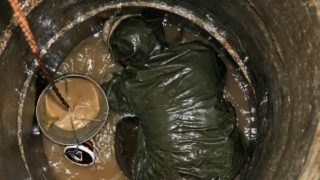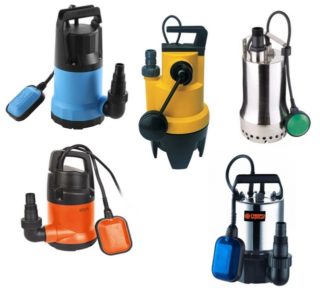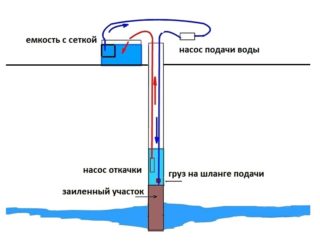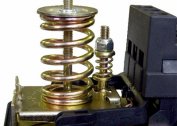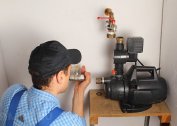In spring, when the groundwater level rises sharply, snow melts and it rains, one problem appears in suburban areas. Wells, from which water is taken for domestic purposes, are filled with dirty water almost to the neck. In this case, a strong siltation of the bottom occurs. The owner of the hydraulic structure will have to clean it.
How to clean a well
The easiest way to use it for a long time: take a bucket, tie a rope to it and start scooping up liquid until the well is completely free. After that, the bottom is cleaned with shovels - dirt is removed, which is loaded into the same buckets and raised to the surface. This process is laborious, time consuming.
It is easier to pump out water from a well in early spring, for this use pumps (manual and electric) or motor pumps. But those units that are called "drainage" are suitable. This type of pumping equipment is manufactured specifically for pumping contaminated liquids.
Criteria for choosing a drainage pump
Drainage pumping units are divided into two broad categories: surface and submersible. The first are devices that are located on the surface near the wells. A hose or pipe is lowered into the hydraulic structure itself, through which dirty water will be pumped out.
The second - devices that are immersed in the liquid in the well. Dip almost to the bottom (50 cm short). Choose from the two proposed models, taking into account the depth of the source. The former can pump water from a depth of maximum 8 m, the latter can be lowered to 20 m. Submersible models are attached to the well head with a steel cable or polymer cable.
The second selection criterion is the operating conditions of the pump unit, or rather, the degree of water pollution. This refers to what size impurities and in what quantity are present in the well fluid. This parameter must be indicated in the product passport.
- 10-20 mm - a drainage pump for pumping water from a well of medium pollution.
- 20-35 mm - for heavily contaminated water, where there are impurities in the form of pebbles, garbage of various types.
- Z5-50 mm - for pumping water, in which there are stones, branches, household garbage and more.
If the pollution exceeds 50 mm, for pumping water from the well, you need to use a fecal pump, in the design of which a grinder in the form of steel knives is installed. The latter simply grind large impurities (even stones), turning them into a fine fraction.
The dimensions of the impurities are determined by the dimensions of the stainless steel mesh, which is installed on the suction pipe of the pump unit. It is a deterrent to garbage.
The third criterion is the technical and operational characteristics of the drainage pump — productivity and pressure. The first indicator characterizes how much fluid a pump can pump per unit of time. Usually this parameter is designated either l / min, or m³ / hour. This is not the most important criterion if the task is to pump water from the well. You can use a low-power unit, it just takes more time to pump out.
It is imperative to pay attention to pressure. First, everything will depend on how deep the bottom of the hydraulic structure is. Secondly, at what distance it will be necessary to pump out contaminated water. The larger these two linear indicators, the greater should be the pressure at the pump unit.For example, if the pressure on the passport is 30 m, then it will be enough to pump liquid from a depth of 20 m and pump it further at a distance of 100 m. For horizontal movement, it is required 10 times less pressure.
Water pumping technology
Knowing the depth of the hydraulic structure, it is necessary to choose the required cable length for the submersible modification or hose (pipe) for the surface. With the submersible version, they do this:
- they attach a cable, a hose and a cable to the pump, the last two are interconnected with plastic clamps every 1-2 m;
- lower the device into the well to the required depth;
- tie the free end of the cable to the head or to any other fasteners;
- the hose is laid to the place of disposal (usually a ditch, ravine, river or pond outside the countryside), you can drain into the garden;
- turn on the pump for pumping.
In order to maximally clean the source of debris and silt at the bottom, you need to pick up a long pole and stir up the silt layer at the bottom.
Mounting the surface pump is easier. It is installed near the well, a hose is connected to its suction pipe with a length equal to the depth of the structure, and a hose or pipe with a length equal to the distance to the disposal site is connected to the outlet pipe. Then turn on the pump in the socket.
If the well is very dirty, it is better to use two pumps at once to clean it. One will pump clean water from some reservoir. For example, from a barrel standing nearby. Thus, erosion of bottom sediments and dilution of contaminants with water will occur. The second will simply pump out water. As the first device, it is better to use a surface drainage pump, as a second submersible.
This option of pumping and cleaning is economically disadvantageous. Too much electricity will be spent. It’s easier to hire workers who raise all the dirty water in buckets and clean the bottom. But if there are none, two pumps will be the best option. In addition, all this can be done with your own hands.
When pumping water from a well is not recommended
Different situations need to be considered. As practice shows, they often face two problems:
- The well, which was excavated recently, did not have time to cover with a roof or a canopy, draw up a head. The past rain filled the structure with water, mixing it with mud. In this case, it is not necessary to pump out, because the fragile walls of the structure, saturated with water, will collapse (partially or completely). It is recommended to wait until the walls of the well completely shrink.
- You can not pump out water during the active melting of snow. Liquefied soil presses on the bottom from below, raising the water level. The latter, in turn, presses on the ground, preventing it from rising. If you pump out the liquid at this time, the bottom will rise quickly, increasing its level inside the well. This is not bad on the one hand, but in this way you can lose access to the aquifer. Have to deepen the bottom, choosing a raised layer. And these are additional, rather serious financial expenses.
It is necessary to determine the exact time for pumping and cleaning. This is best done in the summer when the water level inside the well is the lowest. There is not much liquid in the structure, it can be pumped out easily and quickly. The process will take a little time.
